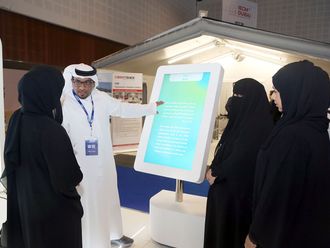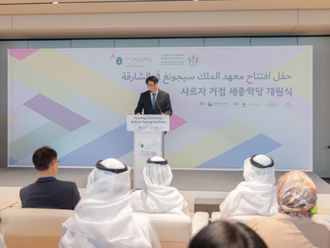The UAE and other Gulf Arab nations have gone a long way in improving the living standards of their people, but several Arab countries have made little progress while the income in others has deteriorated, according to an official report.
While the per capita income, the ratio between the gross domestic product and the population number, surged by at least 20 per cent in the UAE, Qatar, Kuwait and Oman between 1995 and 2000, it improved only slightly in other countries in the region and shrank in some member states, showed the report by the Abu Dhabi-based Arab Monetary Fund and the Arab Fund for Economic and Social Development in Kuwait.
The 2000 figures are in current prices as, in real terms, the per capita income in most regional countries recorded a decline considering the real dollar price and inflation.
The report attributed the slow improvement in most Arab states to a rapid growth in their population, poor investments, heavy taxes and relatively low spending on health, education and other services needed by the poor.
In the UAE, the per capita income jumped by nearly 20 per cent from around $17,500 in 1995 to $21,500 in 2000 and is set to exceed $23,000 this year.
Qatar added more than $7,000 to its per capita income to reach $29,000 in 2000, the highest in the Arab world.
Kuwait's per capita income also surged by around 20 per cent to nearly $16,600, while Oman recorded a 26 per cent growth to $8,200.
Experts attributed such a rapid income growth in these Gulf states to higher oil export earnings and an expansion in non-oil sectors, mainly industry, trade and construction.
Saudi Arabia, which controls a quarter of the world's proven oil wealth, was an exception in the Gulf, recording an increase of only $1,000 to around $7,750 in 2000. The low performance was a result of its rapid population rise, which far exceeded the GDP growth.
Outside the Gulf, poverty remained widespread in most countries and the per capita income improved only slightly in some members while it decreased in others.
Egypt was the only exception outside the Gulf as it made headway in its reforms to spur growth and tackle such economic and social problems as poverty and unemployment. Its per capita income leapt around 50 per cent to $1,515 in 2000 from $1,050 in 1995.
Algeria, which is locked in large scale reforms, also recorded some progress in its anti-poverty drive with the per capita income climbing from $1,470 to $1,750 in the same period.
In other states, there were only slight increases, with Jordan recording an income growth from around $1,560 to $1,650. Per capita income climbed by just $10 to $2,020 in Tunisia, from $352 to $412 in Sudan, and from around $330 to $460 in Yemen. In Morocco, it retreated to around $1,165 from $1,255 while it declined by $100 to $372 in Mauritania.
In the Arab region as a whole, poverty remained one of the most serious problems as there was a steady decline in the real income coupled with inflation and unemployment.
According to the report, around 62 million Arabs, or 22 per cent of the total Arab population, are under the poverty line, earning an average $1 a day. Nearly 145 million, accounting for 62 per cent, are very poor with an average daily income of between $2 and $5.
Individually, around 57 per cent of Mauritania's population is under the poverty line, while the ratio is around 27 per cent in Yemen, 23 per cent in Egypt, 19 per cent in Algeria, 12 per cent in Jordan and six per cent in Tunisia.
In the UAE, Kuwait, Qatar and other Gulf states, it is below one per cent, according to the report, which said the Gulf ratio includes mostly expatriates.
"Between 15 and 30 per cent of the remaining Arab population is slightly above the poverty line...this means they could fall under the line in case there is a slight increase in the living costs," the report said.
It blamed widening poverty in some Arab states to the absence of curbs on the rapid population growth, slow growth in the GDP, and low spending on development.
While most Arab states have managed to rationalise expenditure to boost financial efficiency, the reduction was mostly in development spending, not in current expenditure.
For example, Arab states spent around $172 billion on health, education and social services between 1993 and 1998, an average $28.8 billion a year, which accounted for nearly 6.1 per cent of the GDP. Spending on such sectors was hiked to around $32.7 billion annually between 1999 and 2000 but its level dropped to 5.6 per cent of the GDP.
"It is important to maintain and even increase the ratio of that spending to the GDP...such expenditure is crucial in fighting poverty as providing schools, social services and health care will create the right environment for the poor to improve their conditions," it said.
"Another important factor in tackling poverty is an expansion in investment programmes, especially in remote and poor areas...but it has been noticed that most of the spending cuts were in development expenditure rather than in current spending. This has led to the postponement or even cancellation of several projects in poor areas."
The report also blamed what it described as defective taxation systems in some Arab countries, which it said put additional financial burdens on the poor.
"It is important for Arab states to devise tax systems that take into consideration certain exemptions and incentives for projects and programmes which are directly associated with the development of poor areas and the creation of jobs for the people there," it said.
"It is also important to note that the general tendency to impose new taxes, such as Value Added Tax (VAT), will directly affect the poor more than any other social group despite their significant role in developing revenue. The subsidies policies in several developing countries have also proved their failure in easing the burden on the poor."
High living standards in UAE
The UAE and other Gulf Arab nations have gone a long way in improving the living standards of their people, but several Arab countries have made little progress while the income in others has deteriorated, according to an official report.












